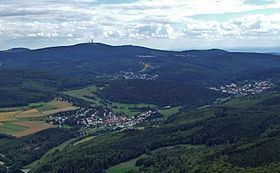Elevation 878 m (2,881 ft) Width 35 km (22 mi) NW/SE Area 2,700 km² | Length 75 km (47 mi) NE/SW | |
 | ||
Mountains Großer Feldberg, Altkönig, Kleiner Feldberg, Bleibeskopf Similar | ||
The Taunus is a mountain range in Hesse, Germany located north of Frankfurt. The tallest peak in the range is Großer Feldberg at 878 m; other notable peaks are Kleiner Feldberg (825 m) and Altkönig (798 m).
Contents
Map of Taunus, 61479 Glash%C3%BCtten, Germany
The Taunus range spans the districts of Hochtaunuskreis, Main-Taunus, Rheingau-Taunus, Limburg-Weilburg, and Rhein-Lahn. The range is known for its geothermal springs and mineral waters that formerly attracted members of the European aristocracy to its spa towns. The car line Ford Taunus is named after it.
DescriptionEdit
It is a relatively low range, with smooth, rounded mountains covered with forest. The Taunus is bounded by the valleys of the Rhine, Main and Lahn rivers and it is part of the Rhenish Slate Mountains. On the opposite side of the Rhine, The Taunus range is continued by the Hunsrück.
For geographical, ecological and geological purposes the Taunus is divided in three parts:
The Taunus range originated during the Devonian period. The geological composition of the mountains was formed in a region covered by an ancient sea that was a few hundred kilometers wide and are mainly made up of phyllite, greenschist, gneiss, slates and sandstone.
SummitsEdit
HistoryEdit
The Roman Limes was built across the Taunus. The Saalburg, a restored Roman castellum, now houses a museum.
After the fall of the Limes (in 259/260 AD), the Alamanni settled in the range and for this reason there are some Alemannic cemeteries in the southern foothills of the Taunus (Eschborn). This area of the Taunus became part of the Frankish confederation of Germanic tribes after the Battle of Tolbiac around 500 AD.
In past centuries the Taunus became famous among aristocrats for its therapeutic hot springs.
Certain towns in the area, such as Bad Homburg vor der Höhe with its Kurpark, have geothermal spas that were formerly renowned. Other spa towns in the Taunus range are Bad Schwalbach (formerly Langenschwalbach) mentioned in documents dating back to the 16th century, Bad Ems, one of the most reputed therapeutic spas in Germany since the 17th century, as well as Bad Weilbach where a spring reached wide fame for some time. By the 19th century the most famous spa towns in the area were Wiesbaden, Bad Homburg vor der Höhe, Bad Nauheim and Bad Soden am Taunus.
